The Economics and Statistics Division maintains archives of previous publications for accountability purposes, but makes no updates to keep these documents current with the latest data revisions from Statistics Canada. As a result, information in older documents may not be accurate. Please exercise caution when referring to older documents. For the latest information and historical data, please contact the individual listed to the right.
<--- Return to Archive
For additional information relating to this article, please contact:
August 05, 2022LABOUR FORCE SURVEY: VISIBLE MINORITIES, JULY 2022 Starting with July 2020, Statistics Canada has added a question to the Labour Force Survey asking respondents about whether they identify with visible minority populations. The population group categories of response are the same as those found in the 2016 Census: White, South Asian (e.g., East Indian, Pakistani, Sri Lankan), Chinese, Black, Filipino, Arab, Latin American, Southeast Asian (e.g., Vietnamese, Cambodian, Laotian, Thai), West Asian (e.g., Iranian, Afghan), Korean, Other.
Labour force characteristics for Indigenous populations are reported separately in the Labour Force Survey.
With the March 2022 release, Statistics Canada made some changes to reporting estimates. Data for Manitoba and Saskatchewan is now being consolidated as Prairie Region. Total population is also changed from 15 to 69 years old to 15 years and over. With the change in the measured population, year-over-year changes are not included in this analysis.
Unless otherwise indicated, data refers to populations aged 15 and over in July 2022. Results are not seasonally adjusted.
July 2022
Nationally, the unemployment rate of those who identify with a visible minority population (6.8%) was higher than the unemployment rate (4.3%) of those that did not identify as Indigenous or in a visible minority population. The unemployment rate for those who identify with a visible minority group was higher than for those who did not identify as Indigenous or in a visible minority population in all regions except for Atlantic Canada. This gap was highest in Quebec. In Atlantic Canada, the unemployment rate was 6.8% both for those that identify with a visible minority group, and for those that did not identify as Indigenous or in a visible minority population.

National participation rates were higher for those who identify with a visible minority population (71.4%) than for those that did not identify as Indigenous or in a visible minority population (63.9%). Participation rates of those who identify with a visible minority population were higher in all regions in July. In Atlantic Canada, those who identify with a visible minority population reported an 77.0% participation rate, compared to a 60.6% participation rate for those that do not identify as Indigenous or in a visible minority population.
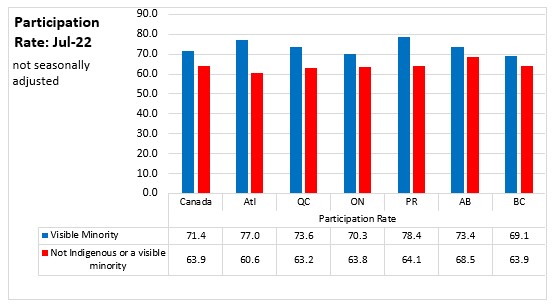
Nationally, employment rates were higher for those who identified with visible minority populations (66.5%) than for those who did not identify as Indigenous or in a visible minority population (61.2%). Employment rates were higher for those who identify with visible minority populations in every region when compared against those who do not identify as Indigenous or in a visible minority population. The gap between the employment rates for those who identified with visible minority populations and those who did not was highest in Atlantic Canada.
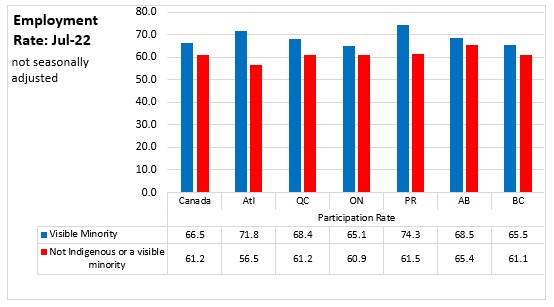
With the release of March 2022 data, Statistics Canada started reporting data estimates for West Asian, Japanese, Korean and multiple visible minority populations which were not available prior to March estimates.
Unemployment rates were higher across almost all visible minority populations than for those who did not identify as Indigenous or in a visible minority population. The exception is among men who identify as Arab or Korean, and Filipino women. The unemployment rate for Japanese men and women was not available for July 2022. (Some of the results for unemployment rates have limited data quality and should be used with caution).

Labour force participation rates for those identifying with a visible minority was higher for men and women when compared those who do not identify as Indigenous or a visible minority. Among those that identified with specific visible minority populations, participation rates were highest among Filipino and Arab men, and Filipino women. Participation rates among women were notably lower than among men for people who identified as South Asian, Arab, Latin American, and West Asian.
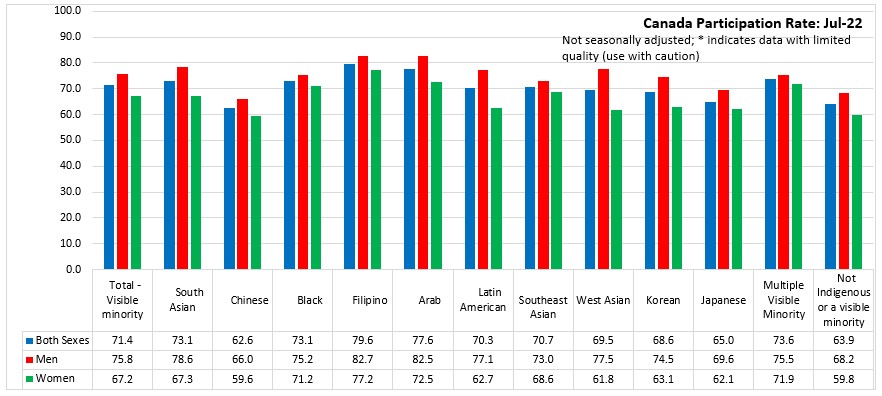
Employment rates among men and women who identify as a visible minority were generally higher than for those who do not identify as Indigenous or a visible minority. Women in all visible minority populations had lower employment rates than men, particularly where lower participation rates and higher unemployment rates were observed.
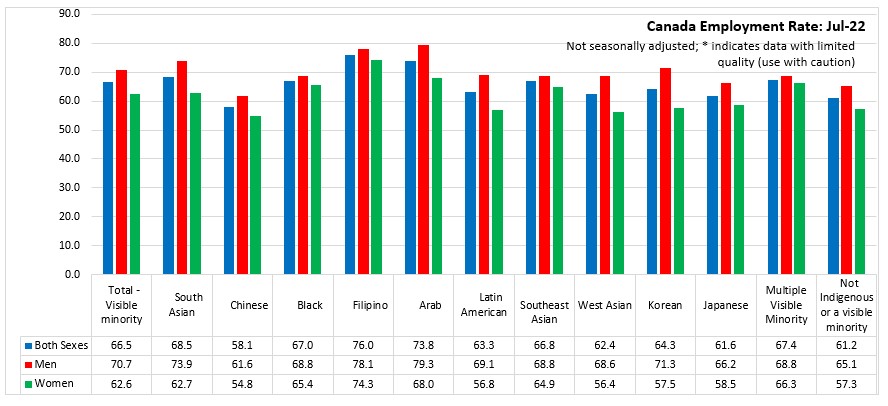
Unemployment rates in Canada were higher for all age cohorts of visible minority populations, when compared with those that do not identify as Indigenous or in a visible minority population.
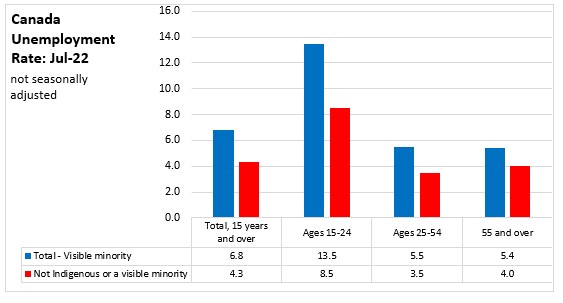
Participation rates of visible minority populations were higher for older workers, compared to the same age cohort that does not identify as Indigenous or visible minority populations. Among youth and core aged workers, participation rates among visible minority populations were lower than among similarly-aged populations that do not identify as Indigenous or in a visible minority population.
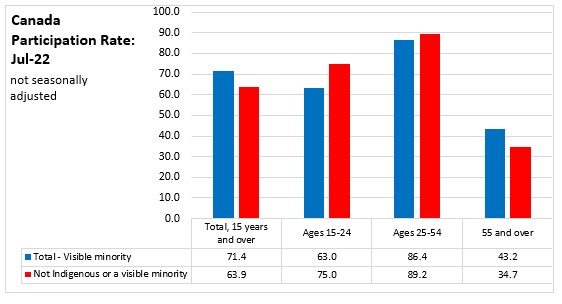
With lower participation and higher unemployment rates, employment rates were lower for visible minority youth and core aged populations. With stronger participation rates (and despite higher unemployment rates), the employment rate of older visible minority populations was higher than older Canadians who do not identify as Indigenous or in a visible minority population.
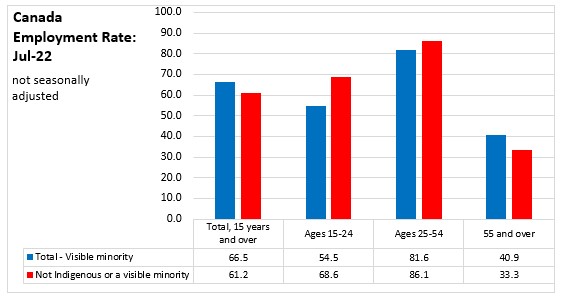
Source: Statistics Canada. Table 14-10-0373-01 Labour force characteristics by visible minority group, three-month moving averages, monthly, unadjusted for seasonality
<--- Return to Archive